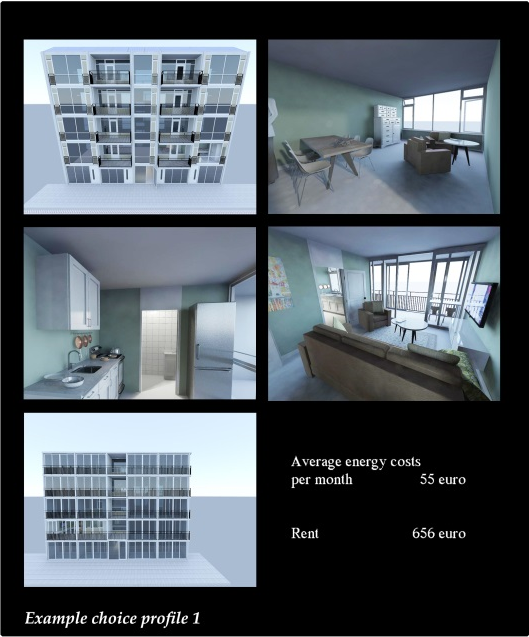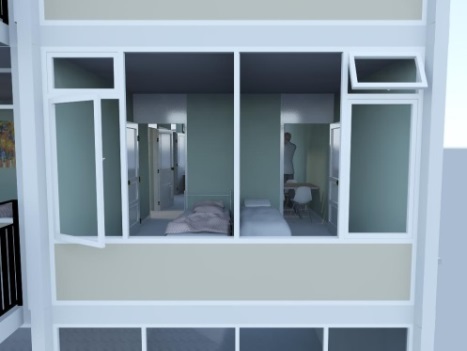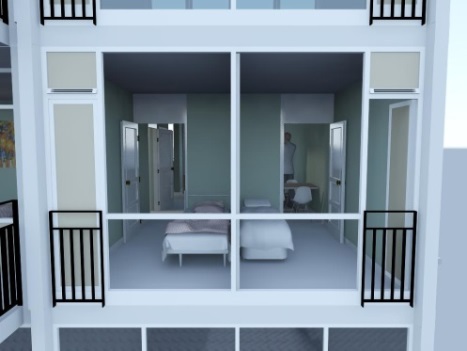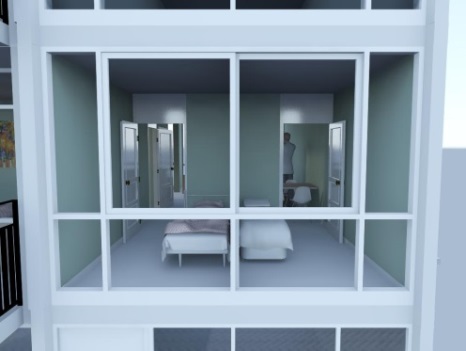Visual choice experiments
Tenants from several housing associations were asked to complete a questionnaire. This questionnaire was based on a series of visual choice experiments comprising two stop motion videos that were shown, after which a tenant could indicate which she or he most preferred.
The stop motion videos showed several design features that were varied according to a pre-specified plan. This plan was developed using a statistical model. There were ten design features with either two or three options per feature. Having so many options meant it was important to use an algorithm to optimise the pre-specified plan. A statistical model and an optimisation procedure were used to create a total of 132 stop motion videos using 3D modelling software. These were presented in pairs. As it would be too much for tenants to view 66 pairs of stop motions, several versions of the survey were made. In the end, each tenants viewed six pairs and thus made six choices. Below we show six stills taken from one pair of stop motion videos.
Thanks to the participating housing associations, many tenants (597 in total) completed the survey. Most completed the online version, but there also was a hard copy available. Knowing which stop motion videos were compared enabled us to relate their choices to the design features and the statistics showed us the tenants’ preferences.
What was varied in the stop motion videos?
The stop motion videos were developed using a transformation framework.
An important feature of the approach used is that tenants were asked to compare configurations. Each configuration showed all the design features as well as the concomitant effect on rent. This is a much better approach than simply asking a tenant whether they like a certain characteristic or not: it is more realistic, because in real life multiple features are weighted. And, importantly, the concomitant costs are also taken into account. This prevents tenants from choosing expensive measures ‘for free’. When it comes to this kind of renovation work, housing associations are entitled to raise rents, so including rent changes makes this process more relevant to tenants and housing associations alike.
The stop motion videos presented 10 features. Since we made 132 stop motion videos, not all options are shown in the examples. The following options were available:
| Feature | Option 1 | Option 2 | Option 3 |
1 | Façade Design | Existing | All glass | Sliding windows |
2 | Energy | Label A | Label B |
|
3 | PV | None | PV | PV + Solar collector |
4 | Acoustic Insulation | Yes | No |
|
5 | Ground floor | 4 studio apartments | 2 studio apartments | Apartments for elderly |
6 | Kitchen | Open | Separate |
|
7 | Access bathroom | Hallway | Kitchen |
|
8 | Number of bedrooms | One | Two | Three |
9 | Extra | None | Elevator | Conservatory |
10 | Rent | Cost-price rent | Cost-price rent plus 3 % | Maximum rent |
An illustration of what the design feature might be like is shown below, with the left showing the existing façade, in the middle the all glass option and on the right-hand side the sliding doors option.
As not all measures are easy to visualise, a voice-over was used. The voice-over explained the apartment to the tenants. Since it was anticipated that not all tenants would be sufficiently proficient in Dutch, the online survey and the voice-over were also available in Arabic, Turkish and English.
Here there are two more stop motion videos to compare:




